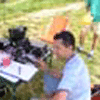HF Wide Open for CQ WW SSB
By Jamie Dupree NS3T
After years of slogging through difficult conditions on the high HF contest bands, the 2011 CQ WW SSB Contest produced especially big numbers on 10 meters in a weekend that thrilled contesters around the world.
“Conditions were incredible,†said Matt Strelow KC1XX on the real 3830 just minutes after the contest ended.
“It was certainly good to have the bands back,†said Frank Donovan W3LPL.
“It was incredible, wasn’t it?†Donovan said to KC1XX and Tim Duffy K3LR as they exchanged their numbers on Sunday night.
Despite major weather troubles on the East Coast of the United States from a surprise October snow storm which put their team on generator power for most of the weekend, KC1XX had 3810 contacts on 15 meters and 3061 QSO’s on 10 meters.
Team K3LR wasn’t far behind with 3473 on 15 meters and 3033 on 10 meters; but while they trailed KC1XX on those two bands, K3LR had the best Multi-Multi score in the US with 37.3 million points. (KC1XX was at 30.3 million and W3LPL at 29.5 million.)
While those 10 meter totals were impressive, it didn’t take long to find a single operator who had even larger 10 meter QSO numbers, like John Crovelli W2GD, who made 3356 contacts on 10 meters from P40W in Aruba.
That spurred P40W to a raw score of just over 15 million points from 7740 QSO’s, 157 zones and 501 countries overall.
The evidence of big action on the high bands in CQ WW SSB was certainly clear on 10 meters, where SSB signals often filled the band up to 29.000 MHz and even above that frequency – in years past it wasn’t odd to hear nothing but noise on that band.
The evidence was also clear on some of the more popular DX cluster sites, some of which seemed overloaded at times over the weekend, supporting both a larger flow of spots and a lot more hams looking for DX.
“Massive signal 59+++†was how G0WUK described the Zone 1 punch of KL7RA from Alaska.
“KL7′s booming on 10 today,†said F8AFC.
“Please split 1000 callers,†pleaded PA0O about the pileup for another Zone 1 station, NL7Z, who at one point was going by numbers for Europe on 10 meters.
“Zone 40 Strong on Bird Feeder,†said N4RJ of one European signal coming in on what might normally not be great antennas for a CQ WW test.
There were so many spots on 10 meters that by 1300z on DX Summit Sunday, the “search†function for the last 10,000 spots on that band didn’t even take you back 24 hours, demonstrating once again the old saying that there’s “no meters like 10 meters.â€
So, instead of everyone crammed into a “meat grinder†on 20 meters, hams were spread out on 20, 15 and 10 meters for the first time since the 2003 CQ WW SSB.
Check back this week for even more updates on scores from the 2011 CQ WW SSB Contest from radio-sport.net.
After years of slogging through difficult conditions on the high HF contest bands, the 2011 CQ WW SSB Contest produced especially big numbers on 10 meters in a weekend that thrilled contesters around the world.
“Conditions were incredible,†said Matt Strelow KC1XX on the real 3830 just minutes after the contest ended.
“It was certainly good to have the bands back,†said Frank Donovan W3LPL.
“It was incredible, wasn’t it?†Donovan said to KC1XX and Tim Duffy K3LR as they exchanged their numbers on Sunday night.
Despite major weather troubles on the East Coast of the United States from a surprise October snow storm which put their team on generator power for most of the weekend, KC1XX had 3810 contacts on 15 meters and 3061 QSO’s on 10 meters.
Team K3LR wasn’t far behind with 3473 on 15 meters and 3033 on 10 meters; but while they trailed KC1XX on those two bands, K3LR had the best Multi-Multi score in the US with 37.3 million points. (KC1XX was at 30.3 million and W3LPL at 29.5 million.)
While those 10 meter totals were impressive, it didn’t take long to find a single operator who had even larger 10 meter QSO numbers, like John Crovelli W2GD, who made 3356 contacts on 10 meters from P40W in Aruba.
That spurred P40W to a raw score of just over 15 million points from 7740 QSO’s, 157 zones and 501 countries overall.
The evidence of big action on the high bands in CQ WW SSB was certainly clear on 10 meters, where SSB signals often filled the band up to 29.000 MHz and even above that frequency – in years past it wasn’t odd to hear nothing but noise on that band.
The evidence was also clear on some of the more popular DX cluster sites, some of which seemed overloaded at times over the weekend, supporting both a larger flow of spots and a lot more hams looking for DX.
“Massive signal 59+++†was how G0WUK described the Zone 1 punch of KL7RA from Alaska.
“KL7′s booming on 10 today,†said F8AFC.
“Please split 1000 callers,†pleaded PA0O about the pileup for another Zone 1 station, NL7Z, who at one point was going by numbers for Europe on 10 meters.
“Zone 40 Strong on Bird Feeder,†said N4RJ of one European signal coming in on what might normally not be great antennas for a CQ WW test.
There were so many spots on 10 meters that by 1300z on DX Summit Sunday, the “search†function for the last 10,000 spots on that band didn’t even take you back 24 hours, demonstrating once again the old saying that there’s “no meters like 10 meters.â€
So, instead of everyone crammed into a “meat grinder†on 20 meters, hams were spread out on 20, 15 and 10 meters for the first time since the 2003 CQ WW SSB.
Check back this week for even more updates on scores from the 2011 CQ WW SSB Contest from radio-sport.net.










